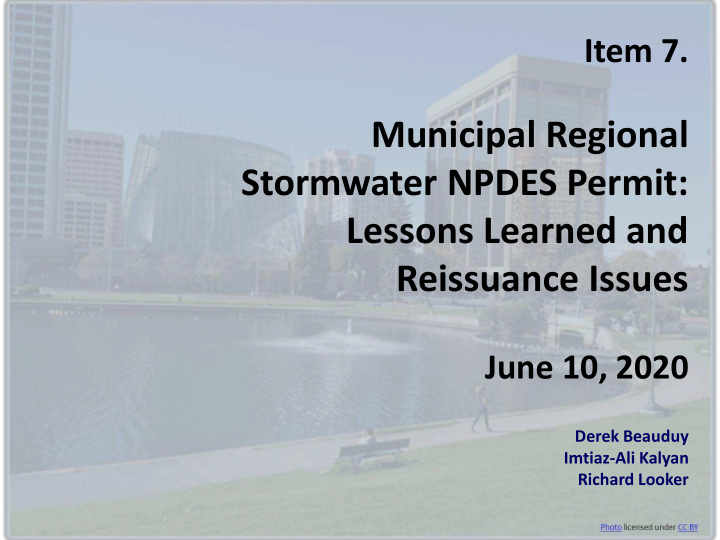



Item 7. Municipal Regional Stormwater NPDES Permit: Lessons Learned and Reissuance Issues June 10, 2020 Derek Beauduy Imtiaz-Ali Kalyan Richard Looker
• Background and schedule • Stakeholder coordination • New requirements and significant updates Overview o Trash o Homelessness o PCBs and mercury o New and redevelopment • Other expected changes • Next steps 2
MRP Background • MRP covers 79 permittees • MRP 1 adopted 2009 • MRP 2 adopted 2015 3
MRP Reissuance Board Action Ongoing Stakeholder Engagement • Public notice and hearings – • Steering Committee began in 2018 winter/spring • Permittee workgroups began in 2019 • Consideration of tentative order by June 2021 4
MRP 3.0: Permittee Coordination Steering Committee Workgroups • Trash • Discharges associated with homelessness • PCBs and mercury • New and redevelopment • Water quality monitoring • Others 5
Potential COVID-19 Impacts 6
Trash Control – MRP 2.0 • Goal : No adverse effect from discharges of trash from significant trash generating areas. o “Turn the map green” (low trash generation rate or equivalent) • MRP 2.0 o 70 percent by July 1, 2017 o 80 percent by July 1, 2019 o Goal of 100 percent by July 1, 2022 • Caltrans coordination 7
Trash Control – MRP 3.0 • MRP 3.0 targets under discussion o 90 percent by July 1, 2022 o 100 percent by end of permit term 8
Credits & Offsets • MRP 2.0 Source Control Credits 10% Creek and Shoreline Cleanup Offset 10% Direct Discharge Program Offset 15% Total: up to 35% • MRP 3.0 Allow credit for new source control actions o Maintain for Permittees who need more time and o to address otherwise uncontrollable trash discharges 9
Homelessness & Water Quality • Discharges of human waste and trash degrade water quality and can threaten public health • Existing Permittee efforts • Actions under discussion o Evaluate and report on scope o Implement doable clean water practices o Coordinate • Landowners • Regional efforts 10
SF Bay PCBs TMDL Urban Stormwater Wasteload Allocation 2 kg/yr 90% load reduction ~20 kg/yr to achieve regionwide 2003 estimate wasteload allocation 20 years after adoption TMDL approved 2010 11
SF Bay PCBs TMDL Urban Stormwater Wasteload Allocation – Phased Implementation Plan focused implementation & develop plans MRP 3 & MRP 1 beyond Implement pilot-scale controls to attain MRP 2 implementation allocations 12
Caulk in older buildings contain PCBs Manage PCBs in building materials – Many 1950 - 1980 buildings used PCBs in caulk – Estimate of PCBs in caulk in Bay Area buildings >10,000 kg! 2 kg/yr load reduction stipulated for managing PCB-containing materials during building demo 13
PCBs mainly found in old industrial areas ringing the Bay 14
PCBs and mercury control in MRP3 – a programmatic approach • Clearly defined program elements • Estimated reductions stipulated in Fact Sheet • Accountability and commitment to implementation • Focus on moderately-contaminated areas (e.g., old industrial areas) 15
New and Redevelopment MRP 2.0 • Low Impact Development design • “Regulated projects” 5,000 or 10,000 square feet of impervious surface o Special Projects o Roads o Single-family homes o • Alternative compliance • Green Infrastructure Plans 16 Photo Credit: Lisa Owens-Viani
New and Redevelopment Potential Changes • Low Impact Development design – no change • “Regulated projects” 5,000 square feet of impervious surface o Special Projects – reduce scope o Roads – significant reworking o Single-family homes – >5,000 square feet o • Alternative compliance – recognize grant- funded project • Green Infrastructure Plans – implement plans "Greened acres" requirement o 17
Other Changes & Next Steps • Many provisions remain mostly unchanged • Continued discussions on: o Key issues o Cost reporting o Electronic reporting o TMDL or similar items specific to individual permittees 18
Conclusion 19
Recommend
More recommend